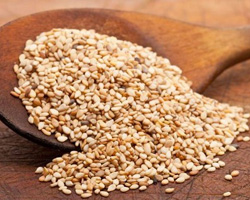 Susam je u ishranu ljudi i u tradicionalnu medicinu ušao pre skoro 6000 godina i od tada se koristi kako za dobijanje kvalitetnog ulja tako i u kombinaciji sa drugim proizvodima (testo, meso, povrće) za pripremanje zdravih i ukusnih jela. Postojbina susama je Azija i od davnina se veruje da on ima posebna svojstva sprečavanja starenja. Spada u grupu mahunarki i bogat je vitaminima A, E, B1 i B6 a od minerala sadrži kalcijum, bakar, gvožđe, cink, i selen. Od drugih jedinjenja značajnih za funkcionisanje organizma sadrži biljna vlakna, niacin, folnu kiselinu, riboflavine, fitosterol i lignane. Bogatsvo navedenih jedinjenja stavlja susam u red najzdravijih semenki čija konzumacija doprinosi smanjenju lošeg holesterola u krvi, prevenciji karcinoma, šećerne bolesti, i visokog krvnog pririska. Susam se može razlikovati i po boji te tako postoji žuti, braon i susam tamne boje. Od ovoga semena dobija se visoko kvalitetno ulje bogato nezacićenim kiselinama koje se koristi u ishrani ljudi ali i u proizvodnji raznih medicinskih preparata.
Susam je u ishranu ljudi i u tradicionalnu medicinu ušao pre skoro 6000 godina i od tada se koristi kako za dobijanje kvalitetnog ulja tako i u kombinaciji sa drugim proizvodima (testo, meso, povrće) za pripremanje zdravih i ukusnih jela. Postojbina susama je Azija i od davnina se veruje da on ima posebna svojstva sprečavanja starenja. Spada u grupu mahunarki i bogat je vitaminima A, E, B1 i B6 a od minerala sadrži kalcijum, bakar, gvožđe, cink, i selen. Od drugih jedinjenja značajnih za funkcionisanje organizma sadrži biljna vlakna, niacin, folnu kiselinu, riboflavine, fitosterol i lignane. Bogatsvo navedenih jedinjenja stavlja susam u red najzdravijih semenki čija konzumacija doprinosi smanjenju lošeg holesterola u krvi, prevenciji karcinoma, šećerne bolesti, i visokog krvnog pririska. Susam se može razlikovati i po boji te tako postoji žuti, braon i susam tamne boje. Od ovoga semena dobija se visoko kvalitetno ulje bogato nezacićenim kiselinama koje se koristi u ishrani ljudi ali i u proizvodnji raznih medicinskih preparata.
